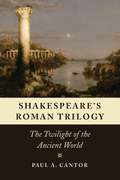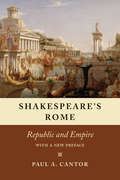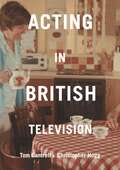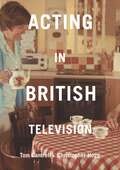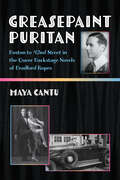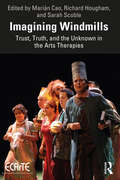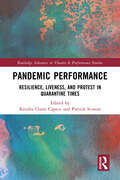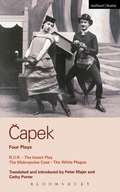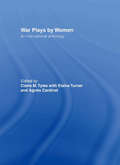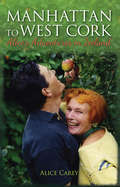- Table View
- List View
New Playwriting at Shakespeare’s Globe
by Vera CantoniShakespeare's Globe Theatre is recognised worldwide as both a monument to and significant producer of the dramatic art of Shakespeare and his contemporaries. But it has established a reputation too for commissioning innovative and distinctive new plays that respond to the unique characteristics and identity of the theatre. This is the first book to focus on the new drama commissioned and produced at the Globe, to analyse how the specific qualities of the venue have shaped those works and to assess the influences of both past and present in the work staged.The author argues that far from being simply a monument to the past, the reconstructed theatre fosters creativity in the present, creativity that must respond to the theatre's characteristic architecture, the complex set of cultural references it carries and the heterogeneous audience it attracts. Just like the reconstructed 'wooden O', the Globe's new plays highlight the relevance of the past for the present and give the spectators a prominent position. In examining the score of new plays it has produced since 1995 the author considers how they illuminate issues of staging, space, spectators, identity and history - issues that are key to an understanding of much contemporary theatre. Howard Brenton's In Extremis and Anne Boleyn receive detailed consideration, as examples of richly productive connection between the playwright's creativity and the theatre's potential. For readers interested in new writing for the stage and in the work of one of London's totemic theatre spaces, New Playwriting at Shakespeare's Globe offers a fascinating study of the fruitful influences of both past and present in today's theatre.
New Playwriting at Shakespeare’s Globe
by Vera CantoniShakespeare's Globe Theatre is recognised worldwide as both a monument to and significant producer of the dramatic art of Shakespeare and his contemporaries. But it has established a reputation too for commissioning innovative and distinctive new plays that respond to the unique characteristics and identity of the theatre. This is the first book to focus on the new drama commissioned and produced at the Globe, to analyse how the specific qualities of the venue have shaped those works and to assess the influences of both past and present in the work staged.The author argues that far from being simply a monument to the past, the reconstructed theatre fosters creativity in the present, creativity that must respond to the theatre's characteristic architecture, the complex set of cultural references it carries and the heterogeneous audience it attracts. Just like the reconstructed 'wooden O', the Globe's new plays highlight the relevance of the past for the present and give the spectators a prominent position. In examining the score of new plays it has produced since 1995 the author considers how they illuminate issues of staging, space, spectators, identity and history - issues that are key to an understanding of much contemporary theatre. Howard Brenton's In Extremis and Anne Boleyn receive detailed consideration, as examples of richly productive connection between the playwright's creativity and the theatre's potential. For readers interested in new writing for the stage and in the work of one of London's totemic theatre spaces, New Playwriting at Shakespeare's Globe offers a fascinating study of the fruitful influences of both past and present in today's theatre.
Shakespeare's Roman Trilogy: The Twilight of the Ancient World
by Paul A. CantorPaul A. Cantor first probed Shakespeare’s Roman plays—Coriolanus, Julius Caeser, and Antony and Cleopatra—in his landmark Shakespeare’s Rome (1976). With Shakespeare’s Roman Trilogy, he now argues that these plays form an integrated trilogy that portrays the tragedy not simply of their protagonists but of an entire political community. Cantor analyzes the way Shakespeare chronicles the rise and fall of the Roman Republic and the emergence of the Roman Empire. The transformation of the ancient city into a cosmopolitan empire marks the end of the era of civic virtue in antiquity, but it also opens up new spiritual possibilities that Shakespeare correlates with the rise of Christianity and thus the first stirrings of the medieval and the modern worlds. More broadly, Cantor places Shakespeare’s plays in a long tradition of philosophical speculation about Rome, with special emphasis on Machiavelli and Nietzsche, two thinkers who provide important clues on how to read Shakespeare’s works. In a pathbreaking chapter, he undertakes the first systematic comparison of Shakespeare and Nietzsche on Rome, exploring their central point of contention: Did Christianity corrupt the Roman Empire or was the corruption of the Empire the precondition of the rise of Christianity? Bringing Shakespeare into dialogue with other major thinkers about Rome, Shakespeare’s Roman Trilogy reveals the true profundity of the Roman Plays.
Shakespeare's Roman Trilogy: The Twilight of the Ancient World
by Paul A. CantorPaul A. Cantor first probed Shakespeare’s Roman plays—Coriolanus, Julius Caeser, and Antony and Cleopatra—in his landmark Shakespeare’s Rome (1976). With Shakespeare’s Roman Trilogy, he now argues that these plays form an integrated trilogy that portrays the tragedy not simply of their protagonists but of an entire political community. Cantor analyzes the way Shakespeare chronicles the rise and fall of the Roman Republic and the emergence of the Roman Empire. The transformation of the ancient city into a cosmopolitan empire marks the end of the era of civic virtue in antiquity, but it also opens up new spiritual possibilities that Shakespeare correlates with the rise of Christianity and thus the first stirrings of the medieval and the modern worlds. More broadly, Cantor places Shakespeare’s plays in a long tradition of philosophical speculation about Rome, with special emphasis on Machiavelli and Nietzsche, two thinkers who provide important clues on how to read Shakespeare’s works. In a pathbreaking chapter, he undertakes the first systematic comparison of Shakespeare and Nietzsche on Rome, exploring their central point of contention: Did Christianity corrupt the Roman Empire or was the corruption of the Empire the precondition of the rise of Christianity? Bringing Shakespeare into dialogue with other major thinkers about Rome, Shakespeare’s Roman Trilogy reveals the true profundity of the Roman Plays.
Shakespeare's Roman Trilogy: The Twilight of the Ancient World
by Paul A. CantorPaul A. Cantor first probed Shakespeare’s Roman plays—Coriolanus, Julius Caeser, and Antony and Cleopatra—in his landmark Shakespeare’s Rome (1976). With Shakespeare’s Roman Trilogy, he now argues that these plays form an integrated trilogy that portrays the tragedy not simply of their protagonists but of an entire political community. Cantor analyzes the way Shakespeare chronicles the rise and fall of the Roman Republic and the emergence of the Roman Empire. The transformation of the ancient city into a cosmopolitan empire marks the end of the era of civic virtue in antiquity, but it also opens up new spiritual possibilities that Shakespeare correlates with the rise of Christianity and thus the first stirrings of the medieval and the modern worlds. More broadly, Cantor places Shakespeare’s plays in a long tradition of philosophical speculation about Rome, with special emphasis on Machiavelli and Nietzsche, two thinkers who provide important clues on how to read Shakespeare’s works. In a pathbreaking chapter, he undertakes the first systematic comparison of Shakespeare and Nietzsche on Rome, exploring their central point of contention: Did Christianity corrupt the Roman Empire or was the corruption of the Empire the precondition of the rise of Christianity? Bringing Shakespeare into dialogue with other major thinkers about Rome, Shakespeare’s Roman Trilogy reveals the true profundity of the Roman Plays.
Shakespeare's Roman Trilogy: The Twilight of the Ancient World
by Paul A. CantorPaul A. Cantor first probed Shakespeare’s Roman plays—Coriolanus, Julius Caeser, and Antony and Cleopatra—in his landmark Shakespeare’s Rome (1976). With Shakespeare’s Roman Trilogy, he now argues that these plays form an integrated trilogy that portrays the tragedy not simply of their protagonists but of an entire political community. Cantor analyzes the way Shakespeare chronicles the rise and fall of the Roman Republic and the emergence of the Roman Empire. The transformation of the ancient city into a cosmopolitan empire marks the end of the era of civic virtue in antiquity, but it also opens up new spiritual possibilities that Shakespeare correlates with the rise of Christianity and thus the first stirrings of the medieval and the modern worlds. More broadly, Cantor places Shakespeare’s plays in a long tradition of philosophical speculation about Rome, with special emphasis on Machiavelli and Nietzsche, two thinkers who provide important clues on how to read Shakespeare’s works. In a pathbreaking chapter, he undertakes the first systematic comparison of Shakespeare and Nietzsche on Rome, exploring their central point of contention: Did Christianity corrupt the Roman Empire or was the corruption of the Empire the precondition of the rise of Christianity? Bringing Shakespeare into dialogue with other major thinkers about Rome, Shakespeare’s Roman Trilogy reveals the true profundity of the Roman Plays.
Shakespeare's Roman Trilogy: The Twilight of the Ancient World
by Paul A. CantorPaul A. Cantor first probed Shakespeare’s Roman plays—Coriolanus, Julius Caeser, and Antony and Cleopatra—in his landmark Shakespeare’s Rome (1976). With Shakespeare’s Roman Trilogy, he now argues that these plays form an integrated trilogy that portrays the tragedy not simply of their protagonists but of an entire political community. Cantor analyzes the way Shakespeare chronicles the rise and fall of the Roman Republic and the emergence of the Roman Empire. The transformation of the ancient city into a cosmopolitan empire marks the end of the era of civic virtue in antiquity, but it also opens up new spiritual possibilities that Shakespeare correlates with the rise of Christianity and thus the first stirrings of the medieval and the modern worlds. More broadly, Cantor places Shakespeare’s plays in a long tradition of philosophical speculation about Rome, with special emphasis on Machiavelli and Nietzsche, two thinkers who provide important clues on how to read Shakespeare’s works. In a pathbreaking chapter, he undertakes the first systematic comparison of Shakespeare and Nietzsche on Rome, exploring their central point of contention: Did Christianity corrupt the Roman Empire or was the corruption of the Empire the precondition of the rise of Christianity? Bringing Shakespeare into dialogue with other major thinkers about Rome, Shakespeare’s Roman Trilogy reveals the true profundity of the Roman Plays.
Shakespeare's Roman Trilogy: The Twilight of the Ancient World
by Paul A. CantorPaul A. Cantor first probed Shakespeare’s Roman plays—Coriolanus, Julius Caeser, and Antony and Cleopatra—in his landmark Shakespeare’s Rome (1976). With Shakespeare’s Roman Trilogy, he now argues that these plays form an integrated trilogy that portrays the tragedy not simply of their protagonists but of an entire political community. Cantor analyzes the way Shakespeare chronicles the rise and fall of the Roman Republic and the emergence of the Roman Empire. The transformation of the ancient city into a cosmopolitan empire marks the end of the era of civic virtue in antiquity, but it also opens up new spiritual possibilities that Shakespeare correlates with the rise of Christianity and thus the first stirrings of the medieval and the modern worlds. More broadly, Cantor places Shakespeare’s plays in a long tradition of philosophical speculation about Rome, with special emphasis on Machiavelli and Nietzsche, two thinkers who provide important clues on how to read Shakespeare’s works. In a pathbreaking chapter, he undertakes the first systematic comparison of Shakespeare and Nietzsche on Rome, exploring their central point of contention: Did Christianity corrupt the Roman Empire or was the corruption of the Empire the precondition of the rise of Christianity? Bringing Shakespeare into dialogue with other major thinkers about Rome, Shakespeare’s Roman Trilogy reveals the true profundity of the Roman Plays.
Shakespeare's Rome: Republic and Empire
by Paul A. CantorFor more than forty years, Paul Cantor’s Shakespeare’s Rome has been a foundational work in the field of politics and literature. While many critics assumed that the Roman plays do not reflect any special knowledge of Rome, Cantor was one of the first to argue that they are grounded in a profound understanding of the Roman regime and its changes over time. Taking Shakespeare seriously as a political thinker, Cantor suggests that his Roman plays can be profitably studied in the context of the classical republican tradition in political philosophy. In Shakespeare’s Rome, Cantor examines the political settings of Shakespeare’s Roman plays, Coriolanus and Antony and Cleopatra, with references as well to Julius Caesar. Cantor shows that Shakespeare presents a convincing portrait of Rome in different eras of its history, contrasting the austere republic of Coriolanus, with its narrow horizons and martial virtues, and the cosmopolitan empire of Antony and Cleopatra, with its “immortal longings” and sophistication bordering on decadence.
Shakespeare's Rome: Republic and Empire
by Paul A. CantorFor more than forty years, Paul Cantor’s Shakespeare’s Rome has been a foundational work in the field of politics and literature. While many critics assumed that the Roman plays do not reflect any special knowledge of Rome, Cantor was one of the first to argue that they are grounded in a profound understanding of the Roman regime and its changes over time. Taking Shakespeare seriously as a political thinker, Cantor suggests that his Roman plays can be profitably studied in the context of the classical republican tradition in political philosophy. In Shakespeare’s Rome, Cantor examines the political settings of Shakespeare’s Roman plays, Coriolanus and Antony and Cleopatra, with references as well to Julius Caesar. Cantor shows that Shakespeare presents a convincing portrait of Rome in different eras of its history, contrasting the austere republic of Coriolanus, with its narrow horizons and martial virtues, and the cosmopolitan empire of Antony and Cleopatra, with its “immortal longings” and sophistication bordering on decadence.
Shakespeare's Rome: Republic and Empire
by Paul A. CantorFor more than forty years, Paul Cantor’s Shakespeare’s Rome has been a foundational work in the field of politics and literature. While many critics assumed that the Roman plays do not reflect any special knowledge of Rome, Cantor was one of the first to argue that they are grounded in a profound understanding of the Roman regime and its changes over time. Taking Shakespeare seriously as a political thinker, Cantor suggests that his Roman plays can be profitably studied in the context of the classical republican tradition in political philosophy. In Shakespeare’s Rome, Cantor examines the political settings of Shakespeare’s Roman plays, Coriolanus and Antony and Cleopatra, with references as well to Julius Caesar. Cantor shows that Shakespeare presents a convincing portrait of Rome in different eras of its history, contrasting the austere republic of Coriolanus, with its narrow horizons and martial virtues, and the cosmopolitan empire of Antony and Cleopatra, with its “immortal longings” and sophistication bordering on decadence.
Shakespeare's Rome: Republic and Empire
by Paul A. CantorFor more than forty years, Paul Cantor’s Shakespeare’s Rome has been a foundational work in the field of politics and literature. While many critics assumed that the Roman plays do not reflect any special knowledge of Rome, Cantor was one of the first to argue that they are grounded in a profound understanding of the Roman regime and its changes over time. Taking Shakespeare seriously as a political thinker, Cantor suggests that his Roman plays can be profitably studied in the context of the classical republican tradition in political philosophy. In Shakespeare’s Rome, Cantor examines the political settings of Shakespeare’s Roman plays, Coriolanus and Antony and Cleopatra, with references as well to Julius Caesar. Cantor shows that Shakespeare presents a convincing portrait of Rome in different eras of its history, contrasting the austere republic of Coriolanus, with its narrow horizons and martial virtues, and the cosmopolitan empire of Antony and Cleopatra, with its “immortal longings” and sophistication bordering on decadence.
Acting in British Television
by Tom Cantrell Christopher HoggActing in British Television is the first in-depth exploration of acting processes in British television. Focused around sixteen new interviews with celebrated British actors, including Rebecca Front, Julie Hesmondhalgh, Ken Stott, Penelope Wilton and John Hannah, this fascinating text delves behind the scenes of a range of British television programmes in order to find out how actors build their characters for television, how they work on set and location, and how they create their critically-acclaimed portrayals. The book looks at actors’ work across four diverse but popular genres: - soap opera - police and medical drama - comedy - period drama Its insightful discussion of hit programmes such as Downton Abbey, Rebus, The Thick of It, Coronation Street and Poldark, and its critical and contextual post-interview analysis, makes the text an essential read for students, academics and anyone interested in acting and British television.
Acting in British Television
by Tom Cantrell Christopher HoggThis fascinating text offers the first in-depth exploration of acting processes in British television. Focused around 16 new interviews with celebrated British actors, including Rebecca Front, Julie Hesmondhalgh, Ken Stott, Penelope Wilton and John Hannah, this rich resource delves behind the scenes of a range of British television programmes in order to find out how actors build their characters for television, how they work on set and location, and how they create their critically acclaimed portrayals. The book looks at actors' work across four diverse but popular genres: soap opera; police and medical drama; comedy; and period drama. Its insightful discussion of hit programmes and its critical and contextual post-interview analysis, makes the text an essential read for students across television and film studies, theatre, performance and acting, and cultural and media studies, as well as academics and anyone interested in acting and British television.
Greasepaint Puritan: Boston to 42nd Street in the Queer Backstage Novels of Bradford Ropes
by Maya CantuGreasepaint Puritan details the life and work of Bradford Ropes, author of the bawdy 1932 novel 42nd Street, on which the classic film and its stage adaptation are based. Inspired by Ropes’s own experiences as a performer, 42nd Street “reads less like a novel than like a documentary about the lives of New York’s theatre people and, above all, about the practicalities, the personalities, and the sexual politics that go into the making of a show,” according to Richard Brody in The New Yorker. Why did Ropes’s body of work--which included a trilogy of backstage novels--and consequently his biographical footsteps, disappear into obscurity? Descended from Mayflower Pilgrims, Ropes rebelled against the “Proper Bostonian” life, in a career that touched upon the Jazz Age, American vaudeville, and theater censorship. Greasepaint Puritan follows Ropes’s successful career as both a performer and the author of the backstage novels 42nd Street, Stage Mother, and Go Into Your Dance. Populated by scheming stage mothers, precocious stage children, grandiose bit players, and tart-tongued chorines, these novels centered on the lives and relationships of gay men on Broadway during the Jazz Age and Prohibition era. Rigorously researched, Greasepaint Puritan chronicles Ropes’s career as a successful screenwriter in 1930s and ’40s Hollywood, where he continued to be a part of a dynamic gay subculture within the movie industry before returning to obscurity in the 1950s. His legacy lives on in the Hollywood and Broadway incarnations of 42nd Street—but Greasepaint Puritan restores the “forgotten melody” of the man who first envisioned its colorful characters.
Cultural Diversity in Motion: Rethinking Cultural Policy and Performing Arts in an Intercultural Society (Theater #144)
by Özlem CanyürekWhat does migration-generated diversity mean for cultural policy and the performing arts scene in Germany and how is it promoted? Through bridging theory and practice, Özlem Canyürek introduces the concept of ›thinking and acting interculturally‹ and proposes a set of criteria as a stepping stone for a semantic shift in cultural policy towards achieving a fair and accessible performing arts scene for all. She delineates the framework conditions of a receptive cultural policy to envision cultural diversity in motion to enable the production and dissemination of multiplicity of thoughts, experiences, knowledge, worldviews, and aesthetics of an intercultural society.
Imagining Windmills: Trust, Truth, and the Unknown in the Arts Therapies
by Marián Cao Richard Hougham Sarah ScobleImagining Windmills presents a compilation of scholarly chapters by selected authors of global standing in the arts therapies. This book reflects the theme of the 15th International Conference of the European Consortium for Arts Therapies (ECArTE), held in Alcalá de Henares, Spain, birthplace of Miguel de Cervantes. This innovative work seeks to further understanding of arts therapy education, practice and research and incorporates current thinking from art therapists, dance-movement therapists, dramatherapists and music therapists. Writers from Belgium, Germany, Greece, India, Israel, Italy, The Netherlands, Spain, Sweden, UK and USA combine to give an international voice to the book, which celebrates cultural distinctiveness, while also presenting shared intercultural developments in the professions. This interdisciplinary publication explores questions of the unknown and the imagined, misconception, delusion, truth and trust in the arts therapies. It enquires into ways in which education and the practice of the arts therapies engage with the imagination as a place of multiple realities, which may lead us closer to finding our truth. This book will be of interest and relevance not only to those in the arts therapeutic community, but also to a broad audience including those in related professions – for instance psychology, sociology, the arts, medicine, health and wellbeing and education.
Imagining Windmills: Trust, Truth, and the Unknown in the Arts Therapies
by Marián López Fdz Cao Richard Hougham Sarah ScobleImagining Windmills presents a compilation of scholarly chapters by selected authors of global standing in the arts therapies. This book reflects the theme of the 15th International Conference of the European Consortium for Arts Therapies (ECArTE), held in Alcalá de Henares, Spain, birthplace of Miguel de Cervantes. This innovative work seeks to further understanding of arts therapy education, practice and research and incorporates current thinking from art therapists, dance-movement therapists, dramatherapists and music therapists. Writers from Belgium, Germany, Greece, India, Israel, Italy, The Netherlands, Spain, Sweden, UK and USA combine to give an international voice to the book, which celebrates cultural distinctiveness, while also presenting shared intercultural developments in the professions. This interdisciplinary publication explores questions of the unknown and the imagined, misconception, delusion, truth and trust in the arts therapies. It enquires into ways in which education and the practice of the arts therapies engage with the imagination as a place of multiple realities, which may lead us closer to finding our truth. This book will be of interest and relevance not only to those in the arts therapeutic community, but also to a broad audience including those in related professions – for instance psychology, sociology, the arts, medicine, health and wellbeing and education.
Pandemic Performance: Resilience, Liveness, and Protest in Quarantine Times (Routledge Advances in Theatre & Performance Studies)
by Kendra Claire CapecePandemic Performance chronicles the many ways that people are surviving/thriving through performance in a global pandemic. Covering artists and events from across the United States: from New York to California and from South Dakota to Texas, the chapters are equal parts theory and practice, weaving scholarship with personal experience from contributors who are interdisciplinary artists, scholars, journalists, and community organizers providing unique and invaluable perspectives on the complicated work of resilience during COVID-19. This study will hold interest for students and scholars in the performing arts, arts, and social justice as well as professional artmakers and creative community organizers.
Pandemic Performance: Resilience, Liveness, and Protest in Quarantine Times (Routledge Advances in Theatre & Performance Studies)
by Kendra Capece Patrick ScoresePandemic Performance chronicles the many ways that people are surviving/thriving through performance in a global pandemic. Covering artists and events from across the United States: from New York to California and from South Dakota to Texas, the chapters are equal parts theory and practice, weaving scholarship with personal experience from contributors who are interdisciplinary artists, scholars, journalists, and community organizers providing unique and invaluable perspectives on the complicated work of resilience during COVID-19. This study will hold interest for students and scholars in the performing arts, arts, and social justice as well as professional artmakers and creative community organizers.
Capek Four Plays: R. U. R.; The Insect Play; The Makropulos Case; The White Plague (World Classics)
by Karel Capek"There was no writer like him. . . prophetic assurance mixed with surrealistic humour and hard-edged social satire: a unique combination" (Arthur Miller)This volume brings together fresh new translations of four of his most popular plays, more than ever relevant today. In R. U. R., the Robot - an idea Çapek was the first to invent - gradually takes over all aspects of human existence except procreation; The Insect Play is a satirical fable in which beetles, butterflies and ants give dramatic form to different philosophies of life; The Makropulos Case is a fantasy about human mortality, finally celebrating the average lifespan; The White Plague is a savage and anguished satire against fascist dictatorship and the virus of inhumanity.
Capek Four Plays: R. U. R.; The Insect Play; The Makropulos Case; The White Plague (World Classics)
by Karel Capek Cathy Porter Peter Majer"There was no writer like him. . . prophetic assurance mixed with surrealistic humour and hard-edged social satire: a unique combination" (Arthur Miller)This volume brings together fresh new translations of four of his most popular plays, more than ever relevant today. In R. U. R., the Robot - an idea Çapek was the first to invent - gradually takes over all aspects of human existence except procreation; The Insect Play is a satirical fable in which beetles, butterflies and ants give dramatic form to different philosophies of life; The Makropulos Case is a fantasy about human mortality, finally celebrating the average lifespan; The White Plague is a savage and anguished satire against fascist dictatorship and the virus of inhumanity.
War Plays by Women: An International Anthology
by Agnes Cardinal Elaine Turner Claire M. TyleeThis anthology consists of ten plays from countries involved in the First World War, including plays from Germany and France never before available in translation. Representing a range of dramatic forms, from radio play to street-epic, from comic sketch to musical, this anthology includes plays from: Gertrude Stein, Muriel Box, Marion Wentworth Craig, Dorothy Hewett, Berta Lask, Marie Leneru, Wendy Lill, Alice Dunbar Nelson, and Christina Reid. Highly successful in their day, these plays demonstrate how women have attempted to use theatre to achieve social change. The collection explores the historical development of theatrical conventions and genres and the historical context of social and gender issues.
War Plays by Women: An International Anthology
by Agnes Cardinal Elaine Turner Claire M. TyleeThis anthology consists of ten plays from countries involved in the First World War, including plays from Germany and France never before available in translation. Representing a range of dramatic forms, from radio play to street-epic, from comic sketch to musical, this anthology includes plays from: Gertrude Stein, Muriel Box, Marion Wentworth Craig, Dorothy Hewett, Berta Lask, Marie Leneru, Wendy Lill, Alice Dunbar Nelson, and Christina Reid. Highly successful in their day, these plays demonstrate how women have attempted to use theatre to achieve social change. The collection explores the historical development of theatrical conventions and genres and the historical context of social and gender issues.
Manhattan to West Cork: Alice's Adventures In Ireland
by Alice CareyAs a young girl Alice Carey came to realise that ‘home’ can mean different things. The only child of Irish immigrants to New York in search of a better life, her isolated and sometimes violent childhood was transformed when her mother started working as maid to legendary Broadway producer Jean Dalrymple. In Miss D.’s elegant Park Avenue town house, Alice was exposed to a life she had only seen in films. Her mother worked to save up enough money for them both to go ‘home’ to Ireland, travelling down below on ocean liners. Ireland in the 1960s was radically different from New York in every way, especially in its morality and attitudes to clerical abuse. Yet despite the darkness, many years later Alice and her husband fell in love with an abandoned Georgian farmhouse in west Cork. As they restored its stables, Alice began unearthing buried childhood memories played out in wildly divergent homes in New York City, Fire Island and Killarney. Manhattan to West Cork is the poignant tale of a young girl raised in a difficult environment juxtaposed with the story of a grown woman trying to make sense of her childhood. "A great read ... Alice started her first diary aged 10; this love of recording may explain her perceptive eye and ear and why the simplicity of her narration draws us in." – Irish Examiner

